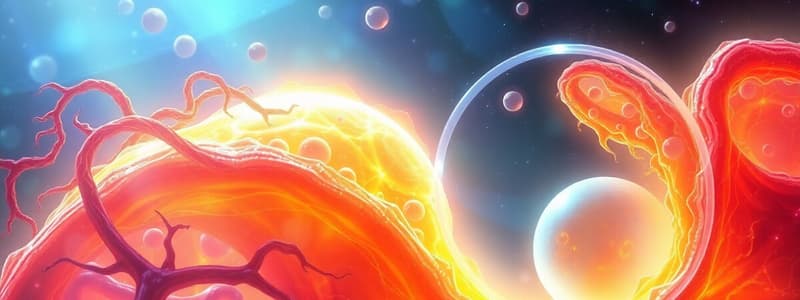Podcast
Questions and Answers
What is the first phase of spermatogenesis?
What is the first phase of spermatogenesis?
- Multiplication Phase (correct)
- Maturation Phase
- Growth Phase
- Development Phase
How many spermatids are produced from each primary spermatocyte?
How many spermatids are produced from each primary spermatocyte?
- Five
- Two
- Three
- Four (correct)
In which phase do spermatogonia grow to form larger cells known as primary spermatocytes?
In which phase do spermatogonia grow to form larger cells known as primary spermatocytes?
- Differentiation Phase
- Growth Phase (correct)
- Multiplication Phase
- Maturation Phase
Which structure contains the haploid number of chromosomes after the first meiotic division?
Which structure contains the haploid number of chromosomes after the first meiotic division?
What is the process called that spermatids undergo to become spermatozoa?
What is the process called that spermatids undergo to become spermatozoa?
What is embryology primarily concerned with?
What is embryology primarily concerned with?
Which of the following best describes asexual reproduction?
Which of the following best describes asexual reproduction?
What is produced during the process of gametogenesis?
What is produced during the process of gametogenesis?
What is the primary function of sperm and ovum in sexual reproduction?
What is the primary function of sperm and ovum in sexual reproduction?
Which of the following is NOT a type of asexual reproduction?
Which of the following is NOT a type of asexual reproduction?
What type of cells do the gonads contain?
What type of cells do the gonads contain?
In which organism type is fragmentation seen as a reproductive method?
In which organism type is fragmentation seen as a reproductive method?
Which of the following statements about sexual reproduction is correct?
Which of the following statements about sexual reproduction is correct?
Flashcards
Oogenesis in ovary
Oogenesis in ovary
The process of producing mature egg cells (ova) in the ovary from primordial germ cells.
Embryology
Embryology
The study of the early development of living organisms.
Asexual Reproduction
Asexual Reproduction
Reproduction that requires only one parent.
Spermatogenesis
Spermatogenesis
Signup and view all the flashcards
Multiplication Phase (Spermatogenesis)
Multiplication Phase (Spermatogenesis)
Signup and view all the flashcards
Splitting (Asexual)
Splitting (Asexual)
Signup and view all the flashcards
Budding (Asexual)
Budding (Asexual)
Signup and view all the flashcards
Meiosis in Spermatogenesis
Meiosis in Spermatogenesis
Signup and view all the flashcards
Spermatids
Spermatids
Signup and view all the flashcards
Sexual Reproduction
Sexual Reproduction
Signup and view all the flashcards
Gametogenesis
Gametogenesis
Signup and view all the flashcards
Spermatogenesis
Spermatogenesis
Signup and view all the flashcards
Ovum
Ovum
Signup and view all the flashcards
Study Notes
Embryology
- Embryology is the study of the early development of living organisms in animals and plants.
- Reproduction is essential for the survival of a species.
Reproduction
-
Asexual reproduction: A single organism splits, buds, or fragments to create two or more individuals.
- Types include splitting (e.g., paramecium), budding (e.g., hydra), and fragmentation (e.g., yeast).
-
Sexual reproduction: Two gametes (sperm and egg) fuse to form a zygote.
- The male gamete (sperm) fuses with the female gamete (ovum).
- This forms a zygote with a diploid number of chromosomes.
- The zygote develops into an embryo, which eventually develops into an organism.
Sexual Reproduction
- Involves fusion of male and female gametes.
- Chromosomes from sperm (n) and ovum (n) combine to form a zygote (2n).
- The zygote undergoes embryonic development, leading to cell division.
- The somatic cells form the organism's body.
Gametogenesis
- The production of gametes (sperm and egg).
- Involves the reduction of chromosomes to haploid sets in the resulting gametes.
- Occurs in the gonads (testis and ovary), and the cells in these gonads are diploid, and the formation of germ cells takes place from them; this phase is called Gametogenesis.
Spermatogenesis
- Spermatogenesis is the process for forming sperm.
- Three phases: multiplication, growth, and maturation.
- Multiplication phase: Repeated mitotic divisions of primordial germ cells to generate spermatogonia.
- Growth phase: Spermatogonia enlarge to become primary spermatocytes.
- Maturation phase: Primary spermatocytes undergo meiosis to produce spermatids, which mature into sperm.
Oogenesis
- Oogenesis is the process of creating eggs.
- Three phases: multiplication, growth, and maturation.
Spermatozoa Structure
- Spermatozoa has the following parts: Head, mid piece, principal piece, and end piece (tail)
- Different types of sperms, depending on the organism (spherical, Y-shaped, pear-shaped, spiral shaped).
Spermatozoa Types
- Sperms are classified into different categories depending on their shape, size, and structure.
- Examples include spherical, Y-shaped, pear-shaped, and spiral-shaped.
- The different types vary based on the organism (amphibians, fish, mammals, reptiles).
Studying That Suits You
Use AI to generate personalized quizzes and flashcards to suit your learning preferences.




